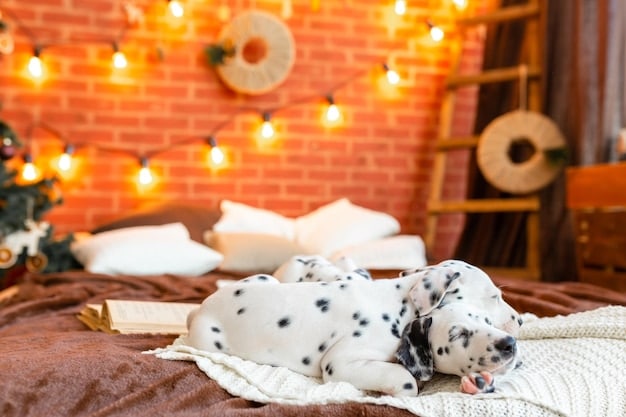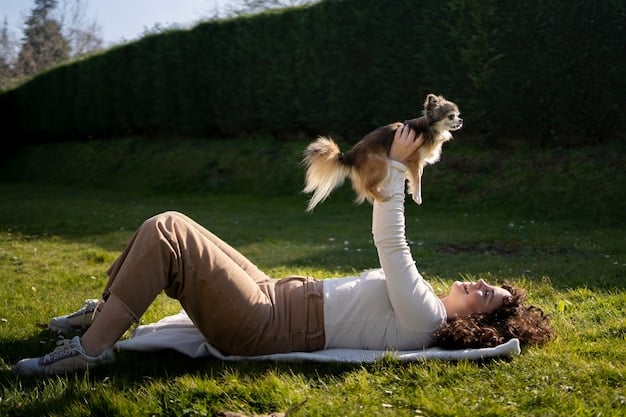Separation Anxiety Solution: Reduce Barking & Whining in 2 Weeks

Anúncios
Separation anxiety solution focuses on behavior modification techniques and environmental adjustments to reduce barking and whining in dogs by up to 50% within two weeks, fostering a calmer and happier pet.
Is your furry friend’s excessive barking and whining turning your departures into a source of stress? The separation anxiety solution you’ve been searching for might be closer than you think.
Anúncios
Understanding Separation Anxiety in Dogs
Separation anxiety isn’t just a case of missed cuddles; it’s a genuine distress signal from your canine companion. Recognizing the signs is the first step towards finding a solution.
What is Separation Anxiety?
Separation anxiety in dogs is a behavioral condition characterized by distress when a dog is left alone or separated from their owners. This distress manifests in various ways, including excessive barking, destructive behavior, and attempts to escape.
Anúncios
Common Signs to Watch For
- Excessive barking or whining when left alone.
- Destructive behavior, such as chewing furniture or scratching doors.
- Urination or defecation indoors, even if the dog is house-trained.
- Pacing or restlessness when the owner prepares to leave.
Addressing separation anxiety requires patience, understanding, and a commitment to implementing effective strategies. By recognizing these signs early, you can start the process of helping your dog feel more secure and comfortable when you’re not around.
In conclusion, understanding the roots and symptoms of separation anxiety ensures that we approach the problem in a thoughtful, considerate manner. By identifying the issue correctly, dog owners can implement tailored strategies that address their pet’s specific needs.
Creating a Safe and Comfortable Environment
A dog’s environment plays a vital role in their emotional well-being. By making strategic adjustments, you can transform your home into a haven that eases separation anxiety.

Designated Safe Space
Creating a designated safe space for your dog can work wonders. This area should be their sanctuary, a place associated with comfort and security.
Essential Elements of the Safe Space
- A comfortable dog bed or crate.
- Favorite toys and chew items.
- A piece of your clothing with your scent.
- Access to fresh water.
Remember, the goal is to create a space where your dog feels secure and content, even when you’re not there. Positive reinforcement, such as treats and praise, can help them associate the space with positive experiences.
By establishing a secure and comfortable environment, we’re offering a proactive solution to our dogs’ separation anxiety. This approach provides them a sense of control of their immediate surroundings, which helps to lower anxiety levels.
Behavior Modification Techniques
Behavior modification techniques are essential tools for addressing separation anxiety. These techniques focus on changing your dog’s emotional response to being left alone.
Desensitization and Counterconditioning
Desensitization involves gradually exposing your dog to triggers that cause anxiety, while counterconditioning aims to change their emotional response from negative to positive.
Step-by-Step Guide to Desensitization and Counterconditioning
- Start with short departures, such as leaving the room for a few seconds.
- Gradually increase the duration of your absences.
- Pair your departures with positive reinforcement, like giving your dog a special treat or toy.
- Avoid making a fuss when leaving or returning.
Consistency is key when implementing these techniques. Be patient and celebrate small victories along the way. Over time, your dog will learn that being alone isn’t something to fear.
By applying behavior modifications like desensitization and counterconditioning, we’re able to directly address the anxiety that our dogs experience. This approach allows owners to change negative associations of being left alone into more positive ones.
The Role of Exercise and Mental Stimulation
A tired dog is often a happy dog. Regular exercise and mental stimulation can significantly reduce anxiety levels.

Physical Exercise and Mental Enrichment
Just like us, dogs thrive on exercise, and can get bored easily and need mental stimulation to stay happy and healthy.
Effective Ways to Incorporate Exercise and Mental Stimulation
- Daily walks or runs.
- Interactive toys and puzzle feeders.
- Training sessions to learn new commands or tricks.
- Playdates with other dogs.
By providing ample opportunities for physical activity and mental challenges, you’re helping your dog release pent-up energy and reduce anxiety-related behaviors. This approach not only addresses separation anxiety but also enhances their overall well-being.
Incorporating exercise into your dog’s daily routine enables them to release pent-up energy, mitigating feelings of anxiety and restlessness. Mental activities encourage dogs to think, preventing stagnation and boredom.
Medication and Professional Help
In some cases, medication may be necessary to manage severe separation anxiety. Consulting a veterinarian or certified behaviorist is crucial in determining the best course of action.
When to Consider Medication
Medication should be considered, if your dog’s separation anxiety is interfering with their quality of life or posing a safety risk.
How a Professional Can Help
- Comprehensive assessment of your dog’s behavior.
- Development of a customized treatment plan.
- Guidance on medication options and potential side effects.
- Ongoing support and adjustments to the treatment plan as needed.
Seeking professional help is a sign of responsible pet ownership. With the right support, you can help your dog overcome separation anxiety and live a happier, more fulfilling life.
Consulting with experts offers tailored solutions for complex cases of separation anxiety. They can give insights and specific modifications of treatment plans better suited for individual dogs.
Consistency, Patience, and Positive Reinforcement
Consistency, patience, and positive reinforcement are vital when working to reduce your dog’s separation anxiety. These elements form the foundation of a successful treatment plan.
Why Consistency Matters
Consistency in your approach is essential for creating a predictable and secure environment for your dog.
Tips for Maintaining Consistency and Patience
- Stick to a regular routine, including feeding times, walks, and playtime.
- Avoid inconsistent responses to anxiety-related behaviors.
- Be patient and remember that progress takes time.
- Use positive reinforcement, such as treats and praise, to reward desired behaviors.
Remember, every dog is unique, and what works for one may not work for another. Be adaptable, stay positive, and celebrate every milestone along the way. Your unwavering support will make all the difference in helping your dog overcome separation anxiety.
By being patient and offering consistent support to their pets, owners can build trust and confidence within their pets, creating a safer and more loving environment at home.
| Key Point | Brief Description |
|---|---|
| 🏠 Safe Space | Create a cozy and secure area for your dog with their favorite items. |
| 🚶 Exercise | Ensure regular physical activity to reduce pent-up energy. |
| 🧠 Mental Stimulation | Provide puzzle toys and training to keep your dog mentally engaged. |
| 💊 Medication | Consult a vet for medication options if anxiety is severe. |
Frequently Asked Questions
▼
Results vary, but many owners see improvements within 2 weeks with consistent training and environmental adjustments.
▼
Gradually increase alone time during training. Avoid long absences initially to prevent setbacks in progress.
▼
Consult a vet or behaviorist if anxiety worsens to adjust the treatment plan or consider medication options.
▼
Yes, puzzle toys keep dogs mentally engaged and reduce anxiety. Choose toys that challenge but don’t frustrate your dog.
▼
Exercise is crucial. Regular physical activity helps reduce stress and pent-up energy that contributes to anxiety.
Conclusion
Tackling separation anxiety requires a blend of empathy, patience, and consistent action. From creating safe havens to employing behavior modification techniques, the journey to alleviating your dog’s anxiety is paved with steps that foster trust and security. Remember, every small victory is a stride towards a happier, calmer companion.






